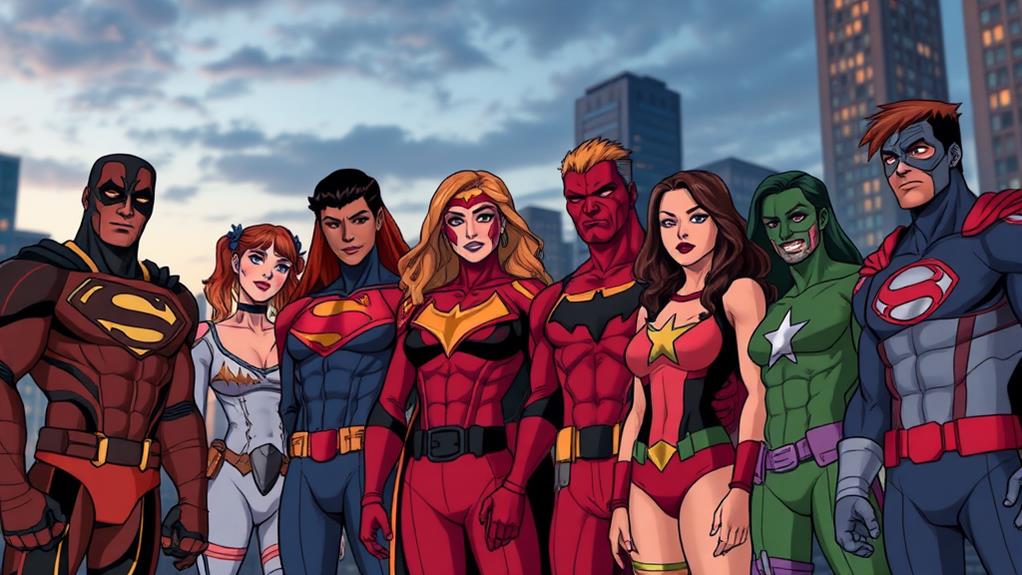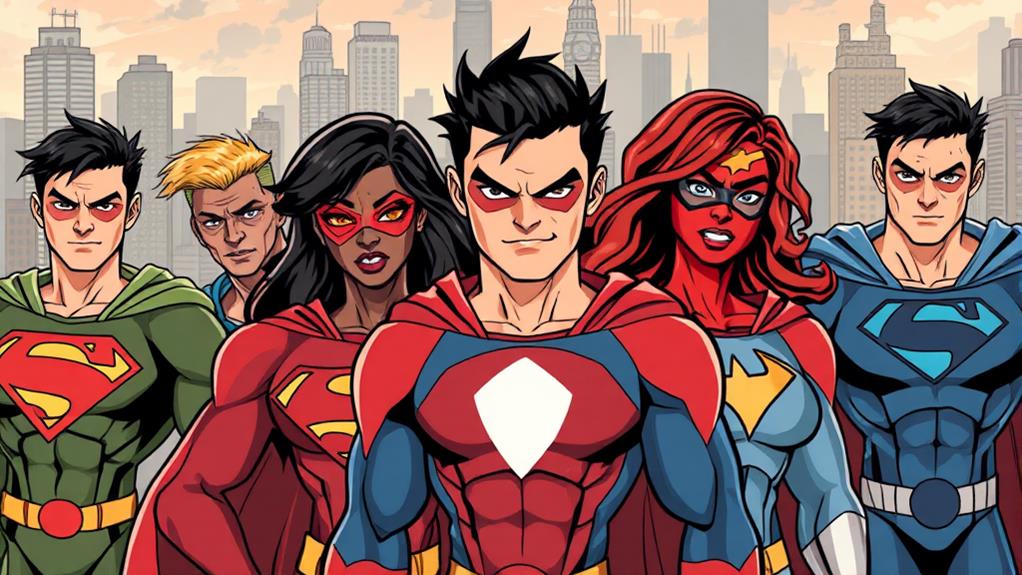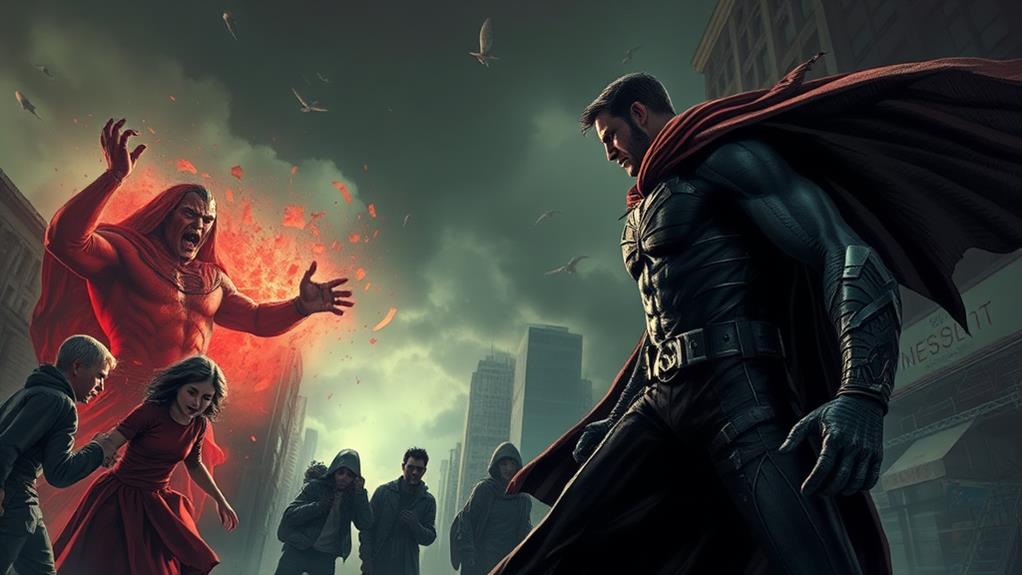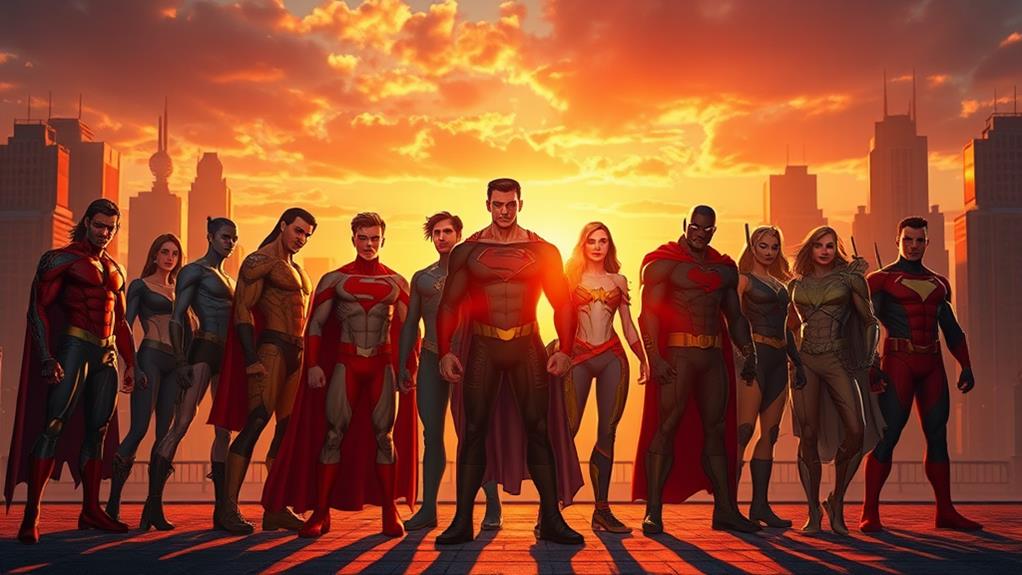
Creating imperfect superhero characters helps you connect with their stories and dilemmas. Their flaws and vulnerabilities make them feel more human, mirroring your own daily challenges. Imperfections drive character growth and add tension, keeping the narrative unpredictable. They reflect real human nature, showing that even heroes struggle and grow, which makes their journeys inspirational. This complexity broadens storytelling possibilities, allowing explorations of deeper themes and diverse genres. Imperfect heroes also encourage stronger emotional connections, fostering reader engagement and sparking discussions. You'll find that these flawed characters open up a world of storytelling depth and excitement.
Enhancing Relatability

Imperfect superhero characters enhance relatability by showcasing flaws and vulnerabilities that make them feel more human. When you see a superhero struggle with personal issues, it's easier to connect with them. They might battle self-doubt, past traumas, or moral dilemmas, just like you do. These imperfections make their stories richer and more engaging because you can see a part of yourself in them.
Consider superheroes like Spider-Man, who juggles school, work, and his responsibilities as a hero. His constant struggle to balance these aspects of his life mirrors the challenges you face daily. It's not just about the powers; it's about the person behind the mask. You understand their fears and aspirations because they're not perfect beings but rather individuals endeavoring to do their best despite their shortcomings.
Driving Character Growth
Often, the imperfections of superhero characters act as catalysts for their personal growth. When you see a superhero struggle with flaws, you witness a journey that mirrors real-life challenges. These imperfections push them to evolve, making their victories more meaningful.
Imagine a hero who starts as arrogant, only to be humbled by failure. Their path to humility teaches them empathy and leadership. Or consider a hero battling self-doubt who learns self-acceptance. These transformations make their stories compelling and relatable.
Here's how imperfections drive growth:
| Imperfection | Challenge Faced | Growth Outcome |
|---|---|---|
| Arrogance | Failure | Humility, Empathy |
| Self-doubt | Self-acceptance | Confidence, Strength |
| Impulsiveness | Consequences | Patience, Strategy |
| Isolation | Loneliness | Connection, Teamwork |
| Fear of Failure | Risk-taking | Resilience, Courage |
Increasing Story Tension

Building tension in superhero stories keeps readers on the edge of their seats. Imperfect characters are key to this. When your superhero has flaws, every challenge they face becomes more unpredictable. Will they overcome it, or will their imperfections trip them up? This uncertainty hooks your audience.
Imagine a hero who has a fear of heights but must save someone from a skyscraper. Their internal struggle amplifies the external conflict, creating a double layer of tension. You're not just worried about the villain; you're also concerned about the hero's mental state. This complexity makes the story more engaging.
Additionally, imperfect superheroes often face moral dilemmas. They might have to choose between saving a loved one or stopping a greater disaster. Their imperfections make these choices harder and more realistic, heightening the stakes. You're left wondering what they'll decide and if they'll regret it later.
Lastly, character flaws can lead to unexpected plot twists. A hero's overconfidence might result in a careless mistake that gives the villain an upper hand. Such moments keep the narrative dynamic and full of suspense, ensuring readers can't put the story down.
Reflecting Human Nature
When superheroes have flaws, they mirror the complexities of real human beings, making them more relatable and authentic. You see, no one is perfect, and that's the beauty of humanity. By giving superheroes imperfections, you can see a reflection of your own struggles, fears, and doubts in them. This connection makes their stories more engaging because you can empathize with their challenges and triumphs.
Imagine a hero who's always right and never falters. It's hard to connect with someone who seems so distant from your reality. On the other hand, a hero who makes mistakes, wrestles with moral dilemmas, or faces personal issues feels much closer to your own experience. This relatability makes the character more compelling and their journey more impactful.
Moreover, these imperfections highlight the heroes' resilience and growth. When you watch them confront and overcome their flaws, it serves as a powerful reminder that you too can rise above your own limitations. The raw humanity in their stories offers hope and inspiration, showing that greatness doesn't require perfection. Instead, it's about endeavoring to be better despite your imperfections.
Broadening Storytelling Possibilities

Imperfect superhero characters don't just make stories more relatable; they also open up a wealth of storytelling possibilities. When heroes are flawed, you can explore a broader range of conflicts, both internal and external. A superhero grappling with self-doubt or personal loss offers a rich narrative landscape. These imperfections allow you to plumb into themes like redemption, sacrifice, and the struggle to overcome one's limitations.
Moreover, imperfect heroes can face more complex villains. A hero with a dark past might encounter an antagonist who exploits these vulnerabilities, creating tension and depth. This kind of storytelling challenges you to think beyond the traditional good-versus-evil trope, making your narratives more nuanced and engaging.
Additionally, by creating imperfect superheroes, you can explore diverse genres. For instance, a hero dealing with mental health issues might fit seamlessly into a psychological thriller. A superhero struggling with addiction could be the centerpiece of a gritty drama. These characters offer you the flexibility to mix and match genres, enriching the storytelling canvas.
Ultimately, embracing imperfection in superheroes allows you to craft stories that are not only mesmerizing but also deeply human, resonating on multiple levels.
Encouraging Reader Engagement
Engaging readers becomes substantially easier when you introduce imperfect superhero characters. These characters, with their flaws and vulnerabilities, create a stronger emotional connection. Readers can see themselves in these heroes, making their journeys more relatable and compelling. When your superhero struggles with self-doubt, makes mistakes, or grapples with personal issues, it creates a rich, multi-dimensional narrative that keeps readers invested.
You'll also find that imperfect heroes open up opportunities for deeper storytelling. Readers love to see characters grow, and flaws provide a fertile ground for development. Each failure or misstep offers a chance for the hero to learn and evolve, mirroring the reader's own life experiences. This dynamic character growth encourages readers to stay enthralled, keen to see how their hero will overcome each new challenge.
Additionally, imperfect superheroes spark conversations and debates. Readers love to discuss and dissect the actions and decisions of characters they care about. By presenting a hero with moral ambiguities or controversial choices, you stimulate reader interaction and build a community around your story. This engagement not only enhances the reading experience but also fosters a loyal and active fan base.
At a Glance
By embracing imperfect superhero characters, you don't just create relatable figures; you ignite a universe brimming with endless possibilities. Their flaws drive explosive growth, ramp up story tension, and mirror the very essence of human nature. Readers will find themselves not just turning pages but living each moment. So, next time you craft a hero, remember: perfection is boring, but imperfection? It's the spark that sets the world ablaze.





